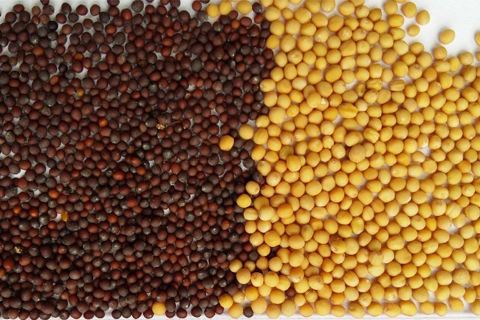The mustard seed belongs to the brassicae family comprising of various plant sub species. The seeds are used as and spices. The white mustard (Sinapsis alba) or the Brassica alba derives its name from the partially white seeds. It is grown widely for seed production, which are used in pickling. The black mustard (Brassica Nigra) is highly pungent and is widely grown in Southeast Asia. The brown mustard seed also has a pungent and acrid taste and is botanically closer to vegetables such as kales, cabbages and collards. It is also widely used as a flavor in Chinese and Japanese cuisines.
The mustard grows well in temperate climates in regions such as Hungary, Britain, Canada, India and the United States.
Culinary Applications
The mustard powder is used as condiment in variety of dishes, dry powder mustard does not have h4 taste, however when mixed with water, enzymatic processes occur enhancing its pungency and sharp flavor. Vinegar is sometimes used to slowdown this enzymatic processes on reaching the required levels. The mustard seeds have been used historically in the production of mustard paste, which then led to the production of mustard condiment for medicinal purposes.

Chemical Composition of Mustard Seed
The pungency property of the mustard is produced by glucosinolates, after hydrolysis of the enzyme myrosinase to form the flavoring isothiocyanates.
Sinalbin is important in flavoring of the white mustard while sinigrin for the sharp and pungent aroma in brown and black mustard seed. Analyzed crude mustard has been found to have 80-94% carbohydrates, and up to 4% proteins.
Nutritional Value of Mustard Seeds
- They are among the most important oil seeds in the world with 100 g of seed giving over 500 calories
- They are good sources of selenium, Manganese and as well as Omega 3 fatty acids. Other nutritional elements include phosphorous, magnesium, copper and Vitamin B1
- They are very good sources of B-complex vitamins such as folates, Niacin, thiamin, riboflavin, pyridoxine (Vitamin B6) and pantothenic acid. These are important in the body in synthesis of enzymes.
- They have higher levels of plant sterols such as brassicasterol and campesterol. Some glucosinolates and fatty acids in the seeds include sinigrin, myrosin, erucic and oleic acids.
- The seeds contain flavonoids, carotenoids, and relatively smaller amounts of vitamin A, C, and K.
- They have healthy minerals such as calcium, manganese, copper, Iron, selenium, and zinc. In the body calcium is important in bones and teeth formation while manganese is a cofactor in the antioxidant superoxide dismutase.
Applications in pharmacology
Research is still ongoing on the potential cancer chemo protective activity of isothiocyanates. Brassica Juncea is a natural source of the antioxidant alpha – tocopherol. The allyl isothiocyanate has anti microbial and antifungal Activity and the mustard oil has inhibitory effect on action of Escherichia coli and salmonella bacteria.
Conclusion
The mustard seed belong to the brassicae family and are known for various nutritional values. Utilization of the mustard seed is growing rapidly due to the increasing concerns about healthy foods. Research has shown that the plant also has medicinal value such as anti bacterial and anti fungal effects.


